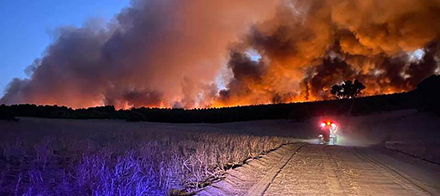It’s hard work fighting a forest fire. It’s hot, dirty and dangerous.
And the heat, dirt and danger doesn’t discriminate between the professionals and the volunteers.
Professional and volunteer firefighters die while fighting bushfires. That’s a sad fact of life and it’s a calculated risk everyone who enters a fire zone takes.
But what is perhaps not a calculated risk is the chances of those same long-term firefighters developing cancer.
The Leukemia & Lymphoma Society in the United States puts it very bluntly – All firefighters, regardless of whether they are career or volunteer, put their own lives at risk to save others in their communities. In addition to the danger of putting out fires, firefighters are at an increased risk for different types of cancer due to the smoke and hazardous chemicals they are exposed to in the line of duty.
There have been multiple studies that show this increased risk for cancer.
The World Health Organisation’s International Agency for Research on Cancer has now officially declared firefighting as a cancer-causing profession, a move with ma-jor implications in how cancer is managed for firefighters and fire services across the world, including Australia.
The WHO IARC announced it was escalating the profession of firefighting from ‘Group 2B – Possibly carcinogenic to humans’ to ‘Group 1 – Carcinogenic to humans’ as part of its ‘Monograph on the identification of carcinogenic hazards to humans’ – an ongoing detailed study of a single specialised subject or an aspect of it.
United Firefighters Union of Australia national secretary Greg McConville told Perth radio the WHO IARC had confirmed beyond any doubt the profession of firefighting causes cancer in firefighters and that this has important implications for Australia’s governments and fire services.
“Studies show that in the first three years of a firefighter’s career, the cancer risk they face increases by 150%, and that’s from looking at actual changes in the DNA of firefighters,” he said.
But as Victorian Forest Products Association CEO Deb Kerr pointed out this week, while the short and long-term risks are the same for every firefighter – their treatment by the government is not. At least not in Victoria.
In New South Wales, for example, paid firefighters and other NSW workers are covered under different workers compensation legislation and as a result, their entitlements are different to volunteer firefighters.
If a volunteer firefighter has suffered a personal injury including exposure (resulting in certain cancers) arising out of or in the course of fighting or journey to a bush fire they have entitlements to weekly payments, medical treatment expenses and a lump sum death benefit.
In Queensland the Workers’ Compensation and Rehabilitation and Other Legislation Amendment Bill 2015 applies to permanent and auxiliary firefighters employed by QFES as well as volunteer firefighters and fire wardens working for the RFS. All firefighters with a claim accepted under the provisions are also entitled to seek common law damages for their disease, including volunteers.
In Victoria, 800 people employed in the forestry sector are members of a Forest Industry Brigade under the Country Fire Authority.
Parliament has recognised that firefighters suffer higher rates of some cancers than the broader community, supporting and passing legislation to provide government-employed firefights presumptive rights.
But as Ms Kerr points out – bad luck if you are a forestry industry firefighter.
She says they do not have the same presumptive rights as their government-employed colleagues when it comes to developing cancer.
“In fact, they are the only firefighters in Victoria that the government has excluded,” she said.
This needs to be changed. This must be changed.
The November State election is an opportunity for pressure to be brought to amend this situation.
Otherwise, and this is an unimaginable concept, the CFA in Victoria might find the fire grounds are short of a few men in the forests.







